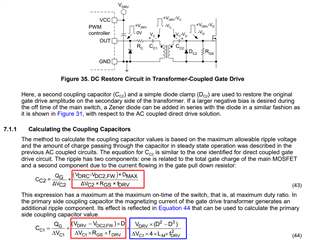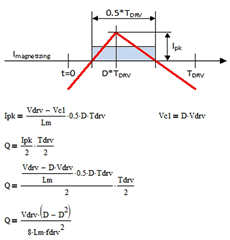Tool/software:
Hello,
After I go over the circuit diagram given in UCC28950 regarding the gate drive circuitry there, then read ''Fundamentals of MOSFET and IGBT Gate Driver Circuits'' written by Laszlo Balogh .
In this document there is a part to calculate the coupling capacitor in section of ''DC Restore Circuit in Transformer-Coupled Gate Drive''. I saw I couple things that I couldn't grasp the idea behind it. Which are as follow :
To calculate the value of Cc1 and Cc2, ripple voltage and the amount of charge passing through the capacitor in steady state is base. That is okay. So I have no issue with the calculation of Cc2 and I understand how the equations of Cc2 is formed. I put a red box somewhere in the calculation, I will explain it later..
Now when we come the calculation of Cc1, the calculations given in the red box for Cc2 is exactly same. However the Cc1 is placed on the primary side and the red box calculation includes the secondary side diode and pulse peaks different between primary and secondary. So why is the same calculation given in red box applied for both Cc1 and Cc2 eventhough the Cc1 is on the primary side ?
My second point is there is statement which is ''In the primary side coupling capacitor the magnetizing current of the gate drive transformer generates an additional ripple component''. I am also agree with that. The blue box given in the Cc1 calculation is related to this sentence, however there is no explanation about how to generate the equation given in blue box. Could you help me to understand how to derive the expression given in blue box ?
Thank you
Best regards




